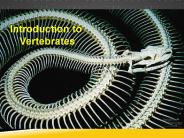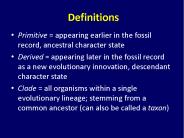Gnathostomes PowerPoint PPT Presentations
All Time
Recommended
IV' Basal Groups of Gnathostomes
| PowerPoint PPT presentation | free to view
Gnathostomes Vertebrates with jaws. Derived Characters Jaws Duplication of Hox genes: Gave rise to larger brains, enhancing smell and vision.
| PowerPoint PPT presentation | free to download
B Molecular structure of the material. Arrangement of ... Supports gills (gill arches), In gnathostomes: jaws. ear. hyoid apparatus. C. Dermatocranium. ...
| PowerPoint PPT presentation | free to download
koalas. Tubulidentata. Aardvark. Hyracoidea. Hyraxes ... Koala. Vertebrates (Ch.34) Chordates. Craniates. Vertebrates. Gnathostomes. Tetrapods. Amniotes ...
| PowerPoint PPT presentation | free to view
Chordates and craniates; Vertebrates; Gnathostomes; Tetrapods, Amniotes, Mammals. ... Mammals ... Mammals. Figure 34.10 A lamprey - an example of a basal vertebrate. ...
| PowerPoint PPT presentation | free to view
Figure 34.2 Echinodermata Cephalochordata ANCESTRAL DEUTEROSTOME Chordates Urochordata Notochord Myxini Craniates Common ancestor of chordates Petromyzontida
| PowerPoint PPT presentation | free to view
The Chordata Chapter 34
| PowerPoint PPT presentation | free to download
FISHES Bio II Rupp GANOID SCALES CTENIOD SCALES CYCLOID SCALES PLACOID SCALES Typical in sharks FISH MUSCULATURE Myomeres-segments of the muscle Myospeta division ...
| PowerPoint PPT presentation | free to view
Feeding Behavior Herbivorous fishes eat plants and micro-algae. Most common on coral reefs parrotfishes, damselfishes, surgeonfishes.
| PowerPoint PPT presentation | free to download
Chapter 34 The Origin and Evolution of Vertebrates
| PowerPoint PPT presentation | free to view
Marine Vertebrates: Lecture 1 Form and Function: Fish (begin)
| PowerPoint PPT presentation | free to download
Vertebrates Emily Reiss Josie Jacob-Dolan Tori Willbanks-Roos
| PowerPoint PPT presentation | free to view
23.1 Relationships among phyla 23.2 Modularity of development: morphogenetic fields 23.3 Modularity of development: enhancers 23.7 The same set of instructions forms ...
| PowerPoint PPT presentation | free to view
... Order Urodela (b) Order Anura (c) Order Apoda Fig. 34-27 (a) Tuatara (Sphenodon punctatus) (c) Wagler s pit viper (Tropidolaemus wagleri) (b) ...
| PowerPoint PPT presentation | free to download
Title: LE 01-10b Author: System_70 Created Date: 12/12/2005 9:42:59 PM Document presentation format: On-screen Show (4:3) Company: PIT Other titles
| PowerPoint PPT presentation | free to download
Elasmobranchs - sharks (360 species in two major groups), skates and rays (450 species) ... Sharks as predators: locate prey in a geographic sense. detect prey ...
| PowerPoint PPT presentation | free to download
Introduction to Vertebrates
| PowerPoint PPT presentation | free to download
Vertebrates Lungfishes Classes of Chordates Tetrapods Classes of Tetrapods Amphibians Urodela ( tailed ones ) Salamanders Anura ( tailless ones ) Frogs and ...
| PowerPoint PPT presentation | free to download
Chordates By Eduardo Alexander Becerra and Caleb Jennings Staurseth
| PowerPoint PPT presentation | free to download
Chapter 34: Phylum Chordata
| PowerPoint PPT presentation | free to download
Vertebrates Linnea Kirby, Michelle Duffy, and Adrienne Vergith-Hill
| PowerPoint PPT presentation | free to view
The parade of the Craniates Part 1 Major synapomorphies of the Craniates Developmental Neural crest Neurogenic placodes Nervous System Above Braincase (skeletal ...
| PowerPoint PPT presentation | free to download
The history of life How to organize our observations regarding changes in the biosphere over time
| PowerPoint PPT presentation | free to download
xmlns:exif='http://ns.adobe.com/exif/1.0/' exif:ColorSpace 1 /exif:ColorSpace ... xmlns:stRef='http://ns.adobe.com/xap/1.0/sType/ResourceRef ...
| PowerPoint PPT presentation | free to view
Vertebrate Adaptations Evolution of the Skeletal System General Trends in the Skeleton Simplification through bone loss, bone fusion, and ossification.
| PowerPoint PPT presentation | free to download
Vertebrate Diversity Chapter 34 Senses: vision, but no color; olfaction; electrical senses * Chordate Phylogeny Phylum Chordata Bilaterian deuterostomes Derived ...
| PowerPoint PPT presentation | free to view
Vertebrate Diversity Chapter 34 Senses: vision, but no color; olfaction; electrical senses * Chordate Phylogeny Phylum Chordata Bilaterian deuterostomes Derived ...
| PowerPoint PPT presentation | free to view
Comparative Anatomy Vertebrate Phylogeny: Fishes Kardong Chapter s 2 & 3 Part 4 Vertebrate Classification Geological Eras of early vertebrates Paleozoic (oldest ...
| PowerPoint PPT presentation | free to view
The Behavior of White Sharks and their Pinniped Prey during predatory attacks ... Focus: reef sharks (requim) Order Orectolobiformes Carpetsharks: Overview ...
| PowerPoint PPT presentation | free to view
Class Osteichthyes: bony fish (salmon, trout) ... bald eagle) Swimming bird (such as a duck) Subphylum Vertebrata. Class Mammalia ...
| PowerPoint PPT presentation | free to view
Title: EVOLUTION PHYLOGENIQUE DE L ATM Author: comes Last modified by: comes Created Date: 2/27/2006 7:11:16 PM Document presentation format: Affichage l' cran
| PowerPoint PPT presentation | free to download
Title: Slide 1 Author: Computing & Information Services Last modified by: reviewer Created Date: 5/12/2006 1:39:39 PM Document presentation format
| PowerPoint PPT presentation | free to download
Vertebrate Animals Highlight what is BOLD/UNDERLINED DOMAIN- Eukarya KINGDOM- Animalia PHYLUM- Chordata SUBPHYLUM- Vertebrata CLASS- 7 different ORDERS- 10 Placental ...
| PowerPoint PPT presentation | free to download
... notochord, caudal fin rays, and what appeared to be a postanal tail and a dorsal ... hypocercal tail (with an extended ventral lobe) which suggest a trend towards ...
| PowerPoint PPT presentation | free to view
Vertebrae Evolution & Diversity
| PowerPoint PPT presentation | free to view
Cerebral Peduncles motor tracts. Cerebral Aqueduct for CSF ... Cerebral peduncle. Cerebellum. Cerebrum. Key Points. Name the 12 cranial nerves in order. ...
| PowerPoint PPT presentation | free to view
Human embryo (5 weeks) Notochord attachment site for muscles ... Platypus. P. Chordata. Mammalia. Monotremes. Echidna. P. Chordata. Mammalia. Marsupials ...
| PowerPoint PPT presentation | free to view
Chapter 34 Vertebrates A. Invertebrate Chordates and the Origin of Vertebrates The vertebrates belong to one of the two major phyla in the Deuterostomia, the ...
| PowerPoint PPT presentation | free to view
Stomodeum invaginates from ectoderm of body covering (breaks through) ... thecodont - fossil birds, crocs and gators, and mammals and imbedded in socket ...
| PowerPoint PPT presentation | free to view
Important developments of the Vertebrates: brain and sense organs The ancestors of vertebrates switched from filter feeding to more active feeding, which required ...
| PowerPoint PPT presentation | free to view
Phylum Chaetognatha- arrow worms (resemble tiny, planktonic fish) More closely related to ... acorn worms. Not related to true worms. Stomochord-- notochord ...
| PowerPoint PPT presentation | free to view
Vertebrate Animals Highlight what is BOLD/UNDERLINED DOMAIN- Eukarya KINGDOM- Animalia PHYLUM- Chordata SUBPHYLUM- Vertebrata CLASS- 7 different ORDERS- 10 Placental ...
| PowerPoint PPT presentation | free to download
Vertebrate Biology Lecture Notes The Phylum Chordata Vertebrates belong to the Phylum Chordata - these are animals that, at one stage or another of their life ...
| PowerPoint PPT presentation | free to view
III' Myxiniformes, Petromyzontiformes
| PowerPoint PPT presentation | free to view
... abundant food source: plankton and suspended organic matter ... no jaws - restricted to plankton, suspended organics - slow growth. Fate of Ostracoderms ...
| PowerPoint PPT presentation | free to view
One of these types of animals gave rise to vertebrates, ... Gnathostomata is subdivided into Pisces with fins and Tetrapoda, usually with two pair of limbs. ...
| PowerPoint PPT presentation | free to view
... stage or another of their life cycle possess the following three characteristics: ... Pisces. Superclass. Tetrapoda. Anamniotes. Amniotes ...
| PowerPoint PPT presentation | free to view
Introduction to Digestive System What is/are the function(s) of the digestive system? What structures are necessary? How does function vary with form?
| PowerPoint PPT presentation | free to view
Title: A View of Life Author: Valued Gateway Client Last modified by: kjones Created Date: 12/9/2002 2:36:15 AM Document presentation format: On-screen Show
| PowerPoint PPT presentation | free to view
Biology 172 Chapter 34 Phylum Chordata Kingdom Animalia Phylum Chordata Kingdom Animalia Phylum Chordata Kingdom Animalia Phylum Chordata Chordate Characteristics ...
| PowerPoint PPT presentation | free to view
Name means cartilaginous fish ... Class Actinistia lobe finned fish. Coelocanth. Class Dipnoi lungfish ... Grasping fingers for tree life. Binocular vision ...
| PowerPoint PPT presentation | free to view
Classification General Features. Basic Unit of Classification = Species. Biological Species Concept = a group of similar-looking individuals capable of ...
| PowerPoint PPT presentation | free to download
None gastrovascular cavity complete digestive system. Body cavities ... Larval urochordate exhibiting paedogenesis* cephalochordate * Early sexual maturity. ...
| PowerPoint PPT presentation | free to download
volution et classification du vivant Emmanuel Bernier Quelques dates 15 MMa : le Big Bang 4,8 MMa : le syst me solaire 4,5 MMa : la Terre 3,8 MMa : l apparition ...
| PowerPoint PPT presentation | free to download
| PowerPoint PPT presentation | free to view
























































